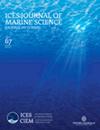Injuries to Pacific mackerel (Scomber japonicus) from underwater explosions
IF 3.4
2区 农林科学
Q1 FISHERIES
引用次数: 0
Abstract
This study expands previous work examining the effects on fishes from exposure to a single 4.5 kg underwater explosive detonation. Experiments were done in the field, with fish in cages at different distances from the source. Although our earlier work reported high acoustic dosage levels (e.g. based on peak pressure) correlating with severe injuries, dosage levels that result in moderate, or mild injuries were not clearly established. Thus, in this study, caged Pacific mackerel (Scomber japonicus) were placed at targeted ranges of 150–800 m from the source. All procedures were the same as in the earlier study except that animals were left at depth for ∼3 hours post-exposure to determine immediate effects on survival. Fish were then retrieved and assessed for physical damage. The only statistically significant tissue injuries were swim bladder bruising and in a reduction in inner ear sensory hair cell density that lessened with distance from the source. Still, results must be taken with caution since they may vary with different source levels, water depths, location of the fish in the water column, and by species.水下爆炸对太平洋鲭鱼造成的伤害
这项研究扩展了之前研究鱼类受到单次 4.5 千克水下爆炸影响的工作。实验是在野外进行的,鱼类被关在距离爆炸源不同距离的笼子里。虽然我们之前的工作报告了与严重伤害相关的高声波剂量水平(例如基于峰值压力),但导致中度或轻度伤害的剂量水平尚未明确确定。因此,在本研究中,将笼养太平洋鲭(Scomber japonicus)放置在距离声源 150-800 米的目标范围内。所有程序都与之前的研究相同,只是在暴露后将动物留在水下 3 小时,以确定对存活率的直接影响。然后将鱼捞出并评估其身体损伤情况。唯一具有统计学意义的组织损伤是鳔淤血和内耳感觉毛细胞密度降低,而这种降低随着与辐射源的距离缩短而减弱。尽管如此,我们仍须谨慎对待这些结果,因为它们可能会因不同的污染源水平、水深、鱼类在水体中的位置和物种而有所不同。
本文章由计算机程序翻译,如有差异,请以英文原文为准。
求助全文
约1分钟内获得全文
求助全文
来源期刊

ICES Journal of Marine Science
农林科学-海洋学
CiteScore
6.60
自引率
12.10%
发文量
207
审稿时长
6-16 weeks
期刊介绍:
The ICES Journal of Marine Science publishes original articles, opinion essays (“Food for Thought”), visions for the future (“Quo Vadimus”), and critical reviews that contribute to our scientific understanding of marine systems and the impact of human activities on them. The Journal also serves as a foundation for scientific advice across the broad spectrum of management and conservation issues related to the marine environment. Oceanography (e.g. productivity-determining processes), marine habitats, living resources, and related topics constitute the key elements of papers considered for publication. This includes economic, social, and public administration studies to the extent that they are directly related to management of the seas and are of general interest to marine scientists. Integrated studies that bridge gaps between traditional disciplines are particularly welcome.
 求助内容:
求助内容: 应助结果提醒方式:
应助结果提醒方式:


